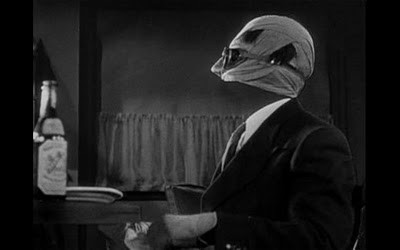
There’s one thing that sets The Invisible Man apart from the rest of the classic monsters: He’s a jerk. Frankenstein Monster, the antagonist of director James Whale’s groundbreaking 1931 film, is dangerous, but childlike. King Kong, who made his screen debut in 1933, the same year as Whale’s The Invisible Man, is a wild animal driven mad by captivity, but he’s not evil. Dracula is a post-human predator, but at least he’s got excellent table manners.
But Dr. Jack Griffin (Claude Rains), the chemist who worked for five years to make himself dissappear, is evil in a banal way. He’s in it for the money. Or at least he was before monocane, the exotic chemical that renders him invisible, turns him into a psychotic megalomaniac. He’s something rare these days: a villain with a realistic motivation and a plausible plan.
Horrortober: The Invisible Man (1933)
Whale is the first of the great horror directors, creating three bona fide masterpieces in a busy four years in which he turned out an astonishing ten films. The Invisible Man is the middle of those, made between the groundbreaking Frankenstein and the gothic majesty of Bride Of Frankenstein. Like Victor Frankenstien, Griffin is a rouge scientist who “meddled in things man was not meant for.” The influence of Mary Shelly on H.G. Well’s 1897 science fiction novel is clear, which may explain why Whale was drawn to the story.
For Rains, this was the role that launched a 40-year career in which he would appear in such indelible classics as The Adventures Of Robin Hood, Casablanca, and Lawrence Of Arabia. When he was a villain, directors would ask him to cloak his evil in gentility. Not so for Whale, who never met a melodramatic flourish he didn’t like. Rains roughly insults and assaults the hapless inkeeper, Mrs. Conner (a hilarious, histrionic Una O’Conner), while ordering her to “bring me food!” He strangles policemen, tips over prams, and blames his victims for his actions.

Whale’s special effects crew pulls out all the stops to bring the Invisible Man to life. They developed a very early version of chroma key, a double exposure technique that is ubiquitous today, for shots such as the darkly comic moment when Griffin steals a policeman’s trousers and chases a terrified milkmaid through the countryside. But even though you know they’re doing it all with wires, such as the classic moment when a bicycle rides itself through the village square, the effects are always expertly deployed so as to create the sense that there is a real person moving through space.
The Invisible Man is overshadowed by Frankenstein and Dracula but it’s every bit their equal, and considerably more sophisticated in its special effects. The simplicity of Well’s premise (“He’s mad, and he’s invisible!” as the police chief says) is spun into a surprising level of psychological and moral sophistication. If no one could see you, you could do whatever you wanted. What would you do?